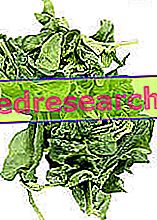What is maple syrup?
Maple syrup is a sweet, viscous and sticky liquid, obtained by carving the trunk of maples (trees of the Acerum genus). The sweet sap that comes out of these incisions contains from 2 to 5% of sucrose; after harvesting, it is then boiled for a long time to evaporate most of the water concentrating the syrup.

Note : other maple species used for the production of syrup are: Manitoba maple ( A. negundo ), silver maple ( A. saccharinum - not to be confused with saccharum ) and Oregon maple ( A. macrophyllum ).
Similar syrups can also be made from birch or palm trees.
Natural sugar substitute
Maple syrup is one of many natural alternatives to refined sugar. Compared to the latter, it boasts a much lower calorific value; in fact, a 10 gram teaspoon provides 26 kcal, compared to the 39 of a similar quantity of sucrose.
The energy power of maple syrup is therefore not negligible, but to save some calories without resorting to artificial sweeteners (whose long-term cumulative effects are, in some ways, still to be clarified), is already a good thing, of course, to provided the doses are not doubled.
Particularly appreciated by those who follow a naturist diet, maple syrup (the famous " maple syrup ") is traditionally used in the preparation of beverages or to flavor cakes, donuts, desserts and various dishes, such as the famous pancakes, waffles, porridge, toast, oatmeal etc.
Many kitchen experts praise the flavor as "unique", even if the chemistry responsible for these characteristics is not yet fully understood.
Historical and commercial outlines
The first to use maple syrup were the native Americans of the northern continent. Subsequently, the European colonists appropriated the system, refining the production method thanks to various technological devices.
The Canadian province of Quebec is the area of greatest production of maple syrup, where up to 70% of the world quota is collected.
In 2016, Canadian exports amounted to around 360 million US dollars (90% from Quebec). In America, the state that produces the most maple syrup is Vermont (it generates about 6% of the global offer).
Types
How many types of maple syrup exist?
According to Canadian legislation, to qualify as such, maple syrup must be produced exclusively from A. saccharum and must contain at least 66% of sugar (sucrose).
Thanks to the organization "International Maple Syrup Institute" (IMSI), in agreement between Canada, the United States and Vermont, maple syrup is differentiated on the basis of density and translucency.
The most recent rules on the classification of maple syrup include:
- Grade A
- Golden color and delicate flavor
- Amber color and rich taste
- Dark color and robust flavor
- Very dark color and strong taste
- Degree of "processing"
- Poor.
Production
How does the production of maple syrup take place?
The extraction of maple syrup does not take place all year round. Instead, it is necessary to respect the biological cycle of the tree and wait for the moment in which it produces the sweet xylem.
In preparation for the cold season, the maple produces and accumulates starch inside the roots and trunk. From the end of winter and into spring (harvest season), the maple converts the starch into sugar and, thanks to the xylem, transports it to all the districts of the plant. Some producers also extract a small amount of syrup in the fall.

An average tree produces up to 12 liters of sweet sap per day (7% of the total sap contained in it), therefore from 35 to 50 liters per season (which lasts about 4-8 weeks).
The syrup is extracted during the day because the lowering of the temperatures inhibits the flow of the viscous liquid.
Video
Properties of maple syrup
Maple Syrup - Video
X Problems with video playback? Reload from YouTube Go to Video Page Go to Wellness Destination Watch the video on youtubePancake Without Butter with Maple Syrup
Follow the recipe of our Personal Cooker, Alice, on MypersonaltrainerTv.
Pancakes without butter
X Problems with video playback? Reload from YouTube Go to Video Page Go to Video Recipes Section Watch the video on youtubeNutritional Properties
Nutritional characteristics of maple syrup
In addition to boasting a much lower calorific value than sugar, maple syrup is also a good source of minerals. This is the main reason why many prefer it to other syrups or simple sugar.
The maple syrup consists mainly of sucrose and water; there are small amounts of glucose and fructose remaining from the hydrolysis of sucrose during the boiling process.
The maple syrup supplies about 260 kcal per 100 g; contains 32% water and 67% carbohydrates (90% disaccharides and monosaccharides). Proteins, fats and fibers are absent or irrelevant; a certain amount of free amino acids is present.
As far as minerals are concerned, maple syrup is considered a good source of manganese, but satisfactory quantities of zinc, calcium and iron are also inferred. Regarding vitamins, a fair level of riboflavin (vitamin B2) is appreciated.
Maple syrup contains a wide variety of volatile organic compounds, including vanillin, hydroxybutanone and propionaldehyde. Together with maple furanone, strawberry furanone and maltol, these compounds contribute to the organoleptic and gustatory structure typical of maple syrup. In all, the flavors identified in the food belong to 13 families: vanilla, empireumatico (burned), milky, fruity, floral, spicy, deteriorated, maple, sugared almond, plants-hummus-cereals, herbaceous and woody.
Recently, new compounds have also been identified such as quebecolo, a natural phenolic element originating from the boiling of maple syrup.
| Maple syrup | |||
| Nutritional values per 100 g | |||
| Power | 260 kcal | ||
| Total carbohydrates | 67.0 g | ||
| Starch | 6.6 g | ||
| Simple sugars | 60.4 g | ||
| fibers | 0.0 g | ||
| Grassi | 0.06 g | ||
| Saturated | - g | ||
| Monounsaturated | - g | ||
| polyunsaturated | - g | ||
| Protein | 0.04 g | ||
| water | 32.4 g | ||
| Vitamins | |||
| Vitamin A equivalent | 0.0 μg | 0.0% | |
| Beta-carotene | 0.0 μg | 0.0% | |
| Lutein Zexanthin | 0.0 μg | ||
| Vitamin A | 0.0 IU | ||
| Thiamine or B1 | 0.066 mg | 6% | |
| Riboflavin or B2 | 1.27 mg | 107% | |
| Niacin or PP or B3 | 0.081 mg | 1% | |
| Pantothenic acid or B5 | 0.036 mg | 1% | |
| Pyridoxine or B6 | 0.002 mg | 0% | |
| folate | 0.0 μg | 0% | |
| Choline | 1.6 mg | 0% | |
| Ascorbic acid or C | 0.0 mg | 0% | |
| Vitamin D | 0.0 μg | 0% | |
| Alpha-tocopherol or E | 0.0 mg | 0% | |
| Vit. K | 0.0 μg | 0% | |
| Minerals | |||
| Football | 102.0 mg | 0% | |
| Iron | 0.11 mg | 1% | |
| Magnesium | 21.0 mg | 6% | |
| Manganese | 2.908 mg | 138% | |
| Phosphorus | 2.0 mg | 0% | |
| Potassium | 212.0 mg | 5% | |
| Sodium | 12.0 mg | 1% | |
| Zinc | 1.47 mg | 15% | |
| Fluoride | - μg | -% | |
Maple syrup disease
What is maple syrup disease?
Leucinosis or "maple syrup disease" is an innate alteration of the metabolism of amino acids. More specifically, the young organism cannot metabolize the so-called BCAAs or branched-chain amino acids (leucine, isoleucine, valine) and eliminates them in large quantities in the urine, giving it a characteristic odor, which is reminiscent of that of maple syrup .
Similar to what happens with phenylketonuria, a special and exclusion dietary regime is currently the only viable way to save the child severe neurological damage.



